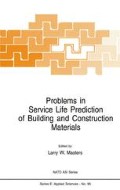Abstract
The service life prediction of inorganic materials is, at present, primarily deduced from studies on mechanical and chemical performance in given environments. Selected models of the behaviour of concrete structures are presented. They are either structural engineering models or materials science models. They can predict mechanical properties, frost resistance or behaviour regarding carbonation. The barriers to service life prediction are related to the complexity of multicomponent systems, to little known degradation mechanisms, to unsatisfactory accelerated tests and to insufficient preventive measures. Examples of chemical deterioration of concrete are given. They emphasize the need for more research in materials science and a closer collaboration between structural engineers and materials scientists.
Access this chapter
Tax calculation will be finalised at checkout
Purchases are for personal use only
Preview
Unable to display preview. Download preview PDF.
References
Wittman, F. H., Modelling of Concrete Behavior. Contemporary European Concrete Research. The Swedish Concrete Inst., 171–190, 1981.
Mindess, S., Mechanical Performance of Cementitious Systems. Structure and Performance of Cements. P. Barnes Ed. Applied Sci. Publishers. 319–364, 1984.
Roelfstra, P. and Wittmann, F. H., Modelling the Time - Dependent Behavior of Concrete. Transactions of the 6th SMIRT. Vol. L. Paper L 1 /4, 1981.
Zaitvev, J. and Wittmann, F. H., Simulation of Crack propagation and Failure of Concrete. Mat. Struc. 14 (83) 357, 1981.
Mihashi, H. and Izumi, M., Stochastic Theory for Concrete Fracture. Cem. Concr. Res. 7, 411–421, 1977.
Sereda, P. J., Feldman, R. F. and Ramachandran, V. S., Formation and Development of Structures in Hardened Cement Pastes. 7th Int. Congress on the Chemistry of Cements. Paris. Vol. I, VI - 1 /3, 1980.
Wittman, F. H., The Structure of Hardened Cement Pastes. A Basis for a Better Understanding of the Materials Properties. Proc. Conf. on Hydraulic Cement Pastes. Their Structure and Properties. 96–117, 1976.
Copeland, L. F. and Verbeck, G. J., Structure and Properties of Hardened Cement Pastes. A Principal Paper. 6th Int. Congress on the Chemistry of Cement. Moscow, 1974.
Powers, T. C. and Brownvard, T. L.., Studies of the Physical Poperties of the Hardened Portland Cement Paste. Portland Cement Association. Res. Bull 22, 1947.
Kendall, K., Howard, A. J. and Birchall, J. D., The relation between Porosity, Microstructue and Strength and the Approach to Advanced Cement - Based Materials. Phil. Trans. R. Soc. London. A 310, 139–153, 1983.
Powers, T. C. and Helmuth, R. A., Theory of Volume Changes in Hardened Portland Cement Paste during Freezing. Proc. Highway Res. Board. 32, 1953.
Litvan, G. G., Freeze-Thaw Durability of Porous Building Materials, ASTM. Spec. Tech. Publ. 691, 1981.
Fagerlund, G., Testing of Frost Resistance. Int. Colloquium on Frost Resistance of Concrete. Vienna, 1980.
Powers, T. C., The Air Requirement of Frost Resistant Concrete. Proc. Highway Res. Board. 19, 1949.
Fagerlund, G., The Critical Degree of Saturation Method of Assessing the Freeze-Thaw Resistance of Concrete. Mat. Struct. Vol. 10, No. 58, 1977.
Pigeon, M., La Microstructure et la Résistance au Gel des Ciments et Bétons. Thèse Doc. Ing. Paris. VI - Juin 1984.
Litvan, G. G., Frost Action in Porous Systems. Int. Sem. on Durability of Concretes and Stones. St. Rémy-lès-Chevreuse, France, 95–108, 1981.
Fagerlund, G., Service Life of Concrete Structures. Ibid Ref. (1), 265–285, 1981.
Houst, Y., Roelfstra, P. E. and Wittmann, F. H., A Model to Predict Service Life of Concrete Structures. Int. Colloquium on Materials Science and Restoration. F. sslingen. W. Germany, 181–186, 1983.
Vénuat, M. et Alexandre J., De la Carbonation du Béton. Rev. Mat. Constr. 683, 421–427 (1968), 639, 469–481 (1968), 640, 5–22 (1969).
Regourd, M., Resistance of Concrete to Chemical Attacks. 32 RCA Rilem. Activity Report. Mat. Struct., 14, 80, 109–137, 1981.
Page, C. L., Short, N. R. and El Tarras, A., Diffusion of Chloride Tons in Hardened Cement Pastes. Cem. Concr. Res. 11, 3, 395–406, 1981.
Regourd, M., Chemical Corrosion of Mineral Building Materials. Ibid Ref. 19. To appear in Bautenschutz + Bausanierung (1984).
Smolczyk, H. G., Structure and Characterization of Slags. Principal Paper. Theme IIT/l. 7th Int. Congress on the Chemistry of Cement. Paris. Vol. I, III - 1 /3, 1980.
Nikitina, L. V., Krassilnikov, K. G. and Lapchina, A. I., La Nature Physico -chimique des Autocontraintes des Ciments Expansifs. Ibid Ref. 23. Vol III, V. 39–44, 1980.
Regourd, M., Durability - Physico-chemical and Biological Processes Related to Concrete. Int. Workshop on Durability of Concrete Structures. Copenhagen (1983) Paper 1. 2.
Oberholster, R. E., Alkali Reactivity of Siliceous Rock Aggregates: Diagnosis of the Reaction, Testing of Cement and Aggregate and Prescription of Preventive Measures. 6th Int. Conf. Alkalies In Concrete, Copenhagen, 419–433, 1983.
Bakker, R. F. M., About the Cause of the Resistance of Blast-furnance Cement Concrete to the Alkali-Silica Reaction, 5th Int. Conf. on Alkali Reaction in Concrete. Cape Town, South Africa. S 252 /29, 1981.
Hobbs, D. W., Expansion of Concrete Due to Alkali-Silica Reaction. The Structural Engineer. Cement and Concrete Association Reprint, 1984.
Author information
Authors and Affiliations
Editor information
Editors and Affiliations
Rights and permissions
Copyright information
© 1985 Martinus Nijhoff Publishers, Dordrecht
About this chapter
Cite this chapter
Regourd, M. (1985). Barriers to the Prediction of Service Life of Inorganic Materials. In: Masters, L.W. (eds) Problems in Service Life Prediction of Building and Construction Materials. NATO ASI Series, vol 95. Springer, Dordrecht. https://doi.org/10.1007/978-94-009-5125-9_3
Download citation
DOI: https://doi.org/10.1007/978-94-009-5125-9_3
Publisher Name: Springer, Dordrecht
Print ISBN: 978-94-010-8766-7
Online ISBN: 978-94-009-5125-9
eBook Packages: Springer Book Archive

